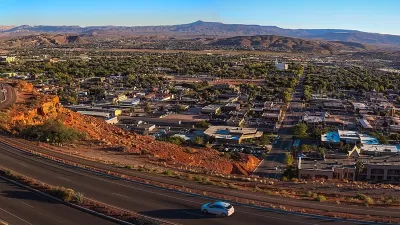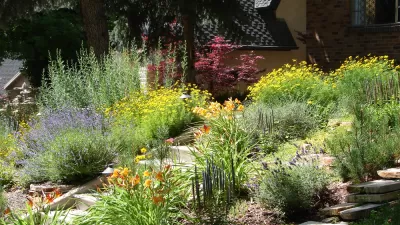The New Yorker traces the history of the American lawn from 1841, commenting on their unnatural origins, and finally analyzing the alternatives suggested by anti-lawn movements.
If one accepts the idea that lawns are, in a deep sense, unethical, how does one fill the front yard?
Over the years, many alternatives to the lawn have been proposed. Pollan, in his book "Second Nature" (1991), suggests replacing parts-or all-of the lawn with garden. In "Noah's Garden" (1993), Sara Stein, by contrast, advocates "ungardening"-essentially allowing the grass to revert to thicket. Sally and Andy Wasowski, in their "Requiem for a Lawnmower" (2004), recommend filling the yard with native trees and wildflowers. For those who don't want to give up the look or the playing space provided by a lawn, the Wasowskis suggest using Buffalo grass, one of the very few turf species native to North America. Smaller American Lawns Today, or SALT, is a concept developed by William Niering, who for many years was a professor of botany at Connecticut College. Niering planted trees around his property, then left most of the rest of his yard unmowed, to become a meadow. "The meadow can take as much of your remaining lawn as you want," he observes in an essay posted on SALT's Web site. "There are some people who prefer no lawn, which is ideal!" For the past few decades, David Benner, a horticulturist from Bucks County, Pennsylvania, has been touting moss as an alternative to grass: he himself has a one-acre "moss garden." Recently, there have been several calls to make the lawnspace productive. In "Food Not Lawns" (2006), Heather C. Flores argues that the average yard could yield several hundred pounds of fruits and vegetables per year. (If you live in an urban area and don't have a lawn, she suggests digging up your driveway.) "Edible Estates" (2008) is the chronicle of a project by Fritz Haeg, an architect and artist, who rips up conventional front yards in order to replace them with visually striking "edible plantings." Haeg calls his approach "full-frontal gardening."
FULL STORY: Turf War

Alabama: Trump Terminates Settlements for Black Communities Harmed By Raw Sewage
Trump deemed the landmark civil rights agreement “illegal DEI and environmental justice policy.”

Study: Maui’s Plan to Convert Vacation Rentals to Long-Term Housing Could Cause Nearly $1 Billion Economic Loss
The plan would reduce visitor accommodation by 25% resulting in 1,900 jobs lost.

Planetizen Federal Action Tracker
A weekly monitor of how Trump’s orders and actions are impacting planners and planning in America.

Wind Energy on the Rise Despite Federal Policy Reversal
The Trump administration is revoking federal support for renewable energy, but demand for new projects continues unabated.

Passengers Flock to Caltrain After Electrification
The new electric trains are running faster and more reliably, leading to strong ridership growth on the Bay Area rail system.

Texas Churches Rally Behind ‘Yes in God’s Back Yard’ Legislation
Religious leaders want the state to reduce zoning regulations to streamline leasing church-owned land to housing developers.
Urban Design for Planners 1: Software Tools
This six-course series explores essential urban design concepts using open source software and equips planners with the tools they need to participate fully in the urban design process.
Planning for Universal Design
Learn the tools for implementing Universal Design in planning regulations.
Caltrans
Smith Gee Studio
Institute for Housing and Urban Development Studies (IHS)
City of Grandview
Harvard GSD Executive Education
Toledo-Lucas County Plan Commissions
Salt Lake City
NYU Wagner Graduate School of Public Service





























